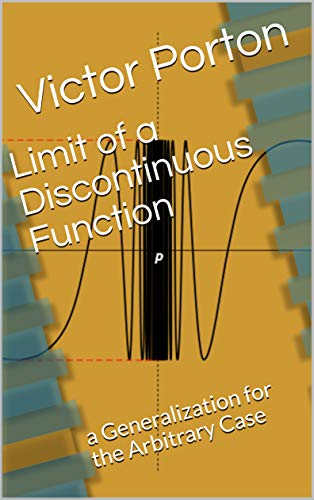Read Discontinuous Analysis for free.
[Algebraic General Topology series]

See also Full course of discontinuous analysis (Algebraic General Topology series)
“No root of -1? No limit of discontinuous function?”
This topic first appeared in peer reviewed by INFRA-M Algebraic General Topology.
See a popular introduction (with graphs).
A New Take on Infinitesimal Calculus with the Limit of Discontinuous Function
Infinitesimal calculus, developed in the late 17th century, is the key to much of modern science, economics and engineering. Calculus is the mathematical study of change, and since we’re surrounded by change in the natural world, the development of calculus was nothing short of a breakthrough! Until recently, the use of infinitesimals was largely neglected for reasons of mathematical rigor; mathematicians hadn’t discovered the correct treatment of infinitesimals.
This book opens a new way to discontinuous calculus. The author succeeds to generalize limits for arbitrary discontinuous functions and proceeds to define non-differentiable solutions of differential equations. The book, “Limit of discontinuous function” not only discusses the foundations of infinitesimal calculus, but also simplifies the students’ grasp of the central concepts of discontinuity and mathematical nondifferentiable analysis. It starts with concepts of basic math, benefitting even novice students to do such things as to find simple solutions of calculations of infinite sums using author’s concept of generalized limit of discontinuous.
The author opens a door to a new world where functions aren’t just functions or analytical expressions; they illustrate profound concepts at a low level of complexity.
Like as once roots were generalized for negative numbers, I succeeded to generalize limits for arbitrary discontinuous functions. Generalized limit allows for example to define derivative of an arbitrary function and integral of an arbitrary function.
The formula of limit of discontinuous function is based on algebraic general topology, my generalization of general topology in an algebraic way.
The formula that defines limit of discontinuous function is surprisingly simple:
lim f = { ν ∘ f ∘ r | r ∈ G }.
(This formula can be enhanced in different ways to make it behave better algebraically, but the idea is this.) And yes, it is very good algebraically, for example y – y = 0 as if it were just a real number!
So we can for example, define derivative of an arbitrary real function. It opens a way to wholly new discontinuous calculus.
There is a problem however: It is not easy to put this generalized derivative into a differential equation, because the left and the right parts of the equation would belong to different sets and we could not simply equate them. I solved this problem, too. So now we have a definition of non-differentiable (and even infinite) solutions of a differential equation.
What will happen next? I don’t know, but maybe for example, we will discover what is the structure at the point of singularity in a black hole.
Important details: My limit is defined not only for real and complex functions, but for example for every function from a vector topological space to a topological space, and even for wider cases including limit of multivalued function and wider!
This book was developed with the caring and concerned adult in mind and is a one-stop for anyone who would like to help a student establish abstract math thinking. They will become adept at the use of math proof strategies throughout their development from birth.
This book provides developmental information, relevant mathematical concepts, and finally activities to engage with to develop mathematical thinking and proving skill.
Elementary general topology theory concentrates on results with a specific geometric meaning, with little algebraic formalism, thus providing proof that some highly nontrivial results are obtained through the procedure.
Important applications become immediately evident without the need for a broad formal.
Originally intended to improve reasoning, creativity, and concentration, this sophisticated yet straightforward book has since expanded beyond the classroom into a global sensation. This is a great book that could make almost anyone love math.